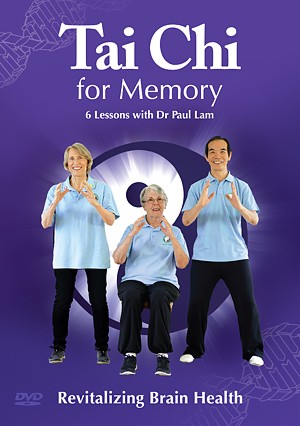How Does Tai Chi for Memory Work?
Dr Paul Lam, Professor Lucy Brown and Rani Hughes
Dr Lam is a family physician and tai chi teacher. His Tai Chi for Health programs have improved health and wellness to millions around the world.
Professor Lucy Brown is a world-famous neuroscientist from Albert Einstein College of Medicine. Her studies of love, attachment, relationship factors and personality by using brain imaging techniques in humans are a milestone in this field.
Rani Hughes is an occupational therapist and Tai Chi for Health Master Trainer from Australia. She has extensive experience teaching Tai Chi to people with dementia.
© Copyright Tai Chi Productions 2019. All rights reserved, no part of this article may be reproduced in any forms or by any means, without permission in writing, except for non-profit educational purpose. For example: you can share this article for a paying participant as long as this article is not included as part of your charge.
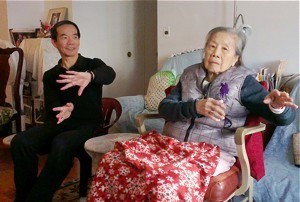
Dr. Lam practicing Tai Chi with his mother.
The combination of Tai Chi movements and breathing is an obvious choice to maintain physical and emotional balance, memory, social interactions and general health. All these effects on the body and mind are needed for people as they age and lose their memory for any number of reasons.
Dr Lam has been working with colleagues to make a program for people with memory loss over the last five years. He was driven to develop this program for many reasons, especially when his mother developed an Alzheimer’s-like disorder. Dr Lam practiced Tai Chi with her and her caregiver weeks before she passed away. Dr Lam reflects, “That memory of practicing Tai Chi with my mother is always with me, I felt more connected with my mother than ever before as we carried out the movements together.”
In this program of Tai Chi for Memory, we emphasize the joy and pleasure Tai Chi can bring.
The Team of Developers and Their Ideas to Make Tai Chi for Memory Work
Professor Rhayun Song, from Chungnam National University, South Korea, joined us to create this program. She helped to design a program for various levels and types of memory loss, and for people without major memory loss, too. Importantly, she refined our goals for the program and designed a research study that is currently being implemented. It will be completed soon. Her goal for the program was to stimulate physical and mental activity through cultivating qi. The inner calm that qi brings, and the physical and mental activity requirements to stimulate qi, are all known to help memory.
Professor Raymond Lau is a rheumatologist from Singapore University. His experience with older adults helped us decide what movements could be accomplished easily and safely by older people. His expertise was a significant contribution to this program.
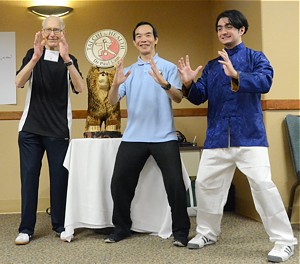
Tai Chi appeals to all ages. Lewis 92 and Mohammed 25 with Dr Lam at a workshop in CO, USA
Rani Hughes is an occupational therapist and Tai Chi for Health Master Trainer from Australia. She has extensive experience teaching Tai Chi to people with dementia. Rani was involved with a pilot project in 2007 to explore how Tai Chi helps when you teach people with dementia and their caregivers together. Like me, her mother unfortunately developed Alzheimer disease so this program touches her both professionally and personally. When Rani joined the team, her ability to draw from both her professional and personal experience was a great asset.
Hazel Thompson, another master trainer, has taught Tai Chi for many years to older adults. Her mother also suffered from dementia. Hazel gave us new ways to think about the program and she made sure the movements were practical for the target audience.
We worked together to help people with memory loss, but also to help prevent these conditions. We wanted to give the caregivers support, too. The team also used acupuncture theory to improve the flow of internal energy, or the qi. Many of the body areas we stimulate in this program are acupuncture points that enhance blood flow and activate the mind.
After working with our team and other experts from the medical and Tai Chi fields, we prepared instructional material and an instructor training curriculum. The instructional videos can be found on our website. The first instructor training workshop was held in South Korea in April 2018. The second workshop took place in October 2018 in Florida, USA. By the end of 2018, there was widespread interest in the Tai Chi for Memory program. The program targets people with dementia and their caregivers, as well as people who wish to prevent dementia.
Features of Tai Chi for Memory
Breathing
A main feature is the dan tian breathing method derived from traditional tai chi breathing, enhanced and simplified by modern medical information. The breathing method is taught in the first lesson and is incorporated throughout the entire program. Tai Chi breathing builds inner muscle and mind strength, the movements we selected assist with building that strength quickly and easily. For inner muscle strength, we focus on the deep stabilizer muscles to fortify the spine and major joints. Importantly, also, the breathing increases oxygenation and blood flow to the brain as well as the entire body. It increases heart rate variability, which affects cognitive areas of the brain in a positive way, too. The emphasis on building inner strength through breathing helps to calm and focus the mind. Dan Tian breathing also helps to activate the parasympathetic nervous system to enhance the body’s power to repair and restore.
Movements to enhance qi and balance
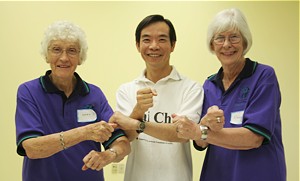
Dr. Lam with over 80 years old Vivian and Mary at a Tai Chi workshop Florida, USA
We deliberately chose slow movements to gently build internal muscle strength instead of selecting movements that emphasise speed and power. Each movement of the program is safe for older people. Some movements incorporate side stepping and conscious weight shifts, which are excellent at improving balance.
A powerful movement of the program is “washing your qi.” This movement stimulates blood flow to the whole body, creating a calming and energizing experience of qi. The brain stimulation is especially important and effective for maintaining body awareness. Such body awareness helps to maintain mindfulness, self concept, autobiographical memories and even spatial memory. It is good to keep these memory functions activated.
Another powerful qi building movement (qigong) is “Ring the Mind Bell.” It massages key acupuncture points for general brain stimulation and calming the mind. Again, it stimulates blood flow to the brain. It encourages the neck muscles to be relaxed and flexible, which is critical for good balance. The antigravity system of the brain’s motor system gets focused stimulation, which is very important for balance and an upright posture.
Short Lessons, in blocks
An important feature of Tai Chi for Memory is the duration of the lessons. We divided the program into four short blocks of varied complexity. People with different levels of dementia and ability can use the blocks that are most suited to them. Short lessons accommodate the reduced memory and attention span that some people with dementia can experience. The lessons can be used individually or connected together to increase the challenge.
For example, Blocks 1 and 2 can be followed by sitting or lying down. Blocks 3 and 4 can still be done sitting or lying down but require more focus to visualise. Because dementia is associated with different degrees of mental and physical ability, the block system is flexible to meet these various needs. We can use different blocks for the different combinations of physical and mental ability.
Chair-friendly
Each lesson has a person doing the movements sitting down. This encourages anyone who cannot stand safely how to follow the movements sitting down. All the movements are chair-friendly.
Other Considerations
Like other Tai Chi for Health programs, this program incorporates the fun element. We know any exercise program provides health benefits, but a safe and fun program is the key to improve adherence.
What makes Tai Chi work for any health benefit is the fundamental principles, like slow, controlled movements, upright posture and a sense of open, relaxed joints. These are embedded in the entire program.
Very importantly, we understand the caregivers are impacted by the condition also. We designed the program to include caregivers to participate too. Then both parties gain the health benefits and share quality time together, just like Dr. Lam did with his mother.
Tai Chi for memory also helps falls prevention
People with dementia have a high risk of falls. We have applied the same Tai Chi principles and key movements as our evidence based Tai Chi for Arthritis and Falls Prevention program. These principles improve balance and muscle strength, cognition and reduce the fear of falling. All of these factors help to prevent falls. The major difference between Tai Chi for Memory and other programs is that the blocks are easier for people with dementia to learn, and they emphasize whole brain activation and frontal lobe activation, important for cognition.
A major reason of Tai Chi’s effect on falls prevention is mind-related. Studies show people with fear of falling are much more likely to fall. The Tai Chi effect on calming the mind and improving confidence correlates closely with reducing the rate of falling.
Science behind Tai Chi’s effectiveness
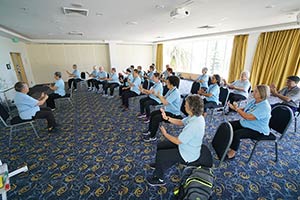
At Dr Lam 21st Annual Tai Chi Workshop in Sydney 2019
Most, if not all of the scientific studies of Tai Chi’s health benefits are based on modified Tai Chi forms. The modified forms are shorter and generally safer compared to ‘traditional’ Tai Chi. One of the studies that supports Tai Chi for Arthritis and Falls Prevention cited by the CDC was done by Prof S. Lord and colleagues. It shows that the type of Tai Chi does not matter so much. The benefits come from the length of practicing. So, to make a short and simple set of movements for older people is important; we want them to enjoy and practice it as much as possible for as long as possible.
In the Tai Chi research review by Tiffany Field (2016), she explores Tai Chi’s effects on cognitive and physical functions. Importantly, the studies show significant improvement on a memory quotient test and improvement in attention, not only balance.
Field, T. (2016, Nov 08) Tai Chi Research Review Journal of Complementary Medicine & Alternative Healthcare Vol 1, Issue 1, p.3.
The article titled,”Tai Chi as a self-management strategy to improve health in people with chronic conditions” provides an overview of how Tai Chi helps with various chronic conditions. The authors discuss how Tai Chi improves quality of life and social capital (p.160) which is especially important for people living with dementia and their caregivers.
Fetherston,C. & Wei, L (2011, Aug 15) The benefits of tai chi as a self management strategy to improve health in people with chronic conditions. Journal of nursing and Healthcare of Chronic Illness Vol 3, Issue 3, p.160.
In 2007, Rani Hughes collaborated with three excellent organizations in Australia (Alzheimers Australia, Arthritis Victoria and Carers Victoria) to explore how Tai Chi helped people with dementia and their caregivers. At the time this was a very progressive idea. The literature review for this project discussed how exercise and Tai Chi is a “protective factor” for the risk of cognitive decline and dementia. It is great to see, ten years on, how Tai Chi has moved into the main stream of health.
All of these results reflect our design and goals for the Tai Chi for Memory program. We would like to see the program help with cognitive decline and dementia for people at all stages, including no detectable dementia; provide social interaction and a rewarding activity; improve attention and self-awareness during the aging process; and reduce anxiety.
*********************************************************************************************************
Brain Studies (see article citations at the end)
Early studies of the benefits of exercise on memory in animals showed that the best activities to improve memory included learning a skill. For example, it was not just running in a wheel for the animals (rats) but running while balancing and learning a path on a set of pipes. Tai Chi includes balance exercise and also learning a movement sequence, a perfect combination for saving our memory as we age.
There are also brain imaging studies in humans that show Tai Chi can improve cognition and moderately reduce falls risk and change brain function in specific neuronal regions. This is impressive evidence that our brain physiology and memory can be changed with Tai Chi. Usually, the studies involve 12 weeks of training in Tai Chi and a health education program as a control. Standard memory tests are given at the beginning and end of the12 weeks. Brain scans show neural changes in the Tai Chi group associated with better memory, especially in cognitive areas associated with spatial memory.
STUDIES of TAI CHI’S BENEFITS TO THE BRAIN, MEMORY AND REDUCING FALLS:
Tao J, Chen X, Liu J, Egorova N, Xue X, Liu W, Zheng G, Li M, Wu J, Hu K, Wang Z, Chen L,, Kong J. Tai Chi Chuan and Baduanjin Mind-Body Training Changes Resting-State Low-Frequency Fluctuations in the Frontal Lobe of Older Adults: A Resting-State fMRI Study. Frontiers in Human Neuroscience, 11:514, 2017.
Tao J, Chen X, Egorova N, Liu J, Xue X, Wang Q, Zheng G, Li M, Hong W, Sun S, Chen L, Kong J Tai Chi Chuan and Baduanjin practice modulates functional connectivity of the cognitive control network in older adults. Scientific Reports.7:41581, 2017.
Zhou M, Liao H, Sreepada LP, Ladner JR, Balschi JA, Lin AP. Tai Chi Improves Brain Metabolism and Muscle Energetics in Older Adults. Journal of Neuroimaging. 28(4):359-364, 2018.

